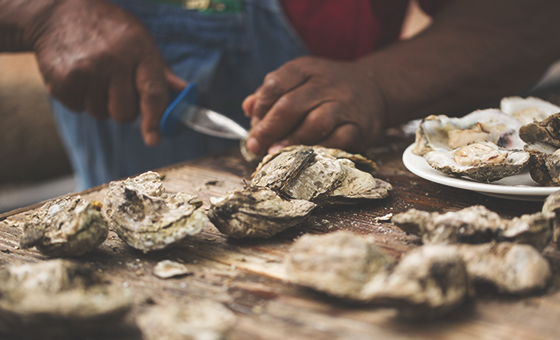post
Mingo Point Oyster Roast:
A 40 Year Tradition

Mingo Point remains one of Kiawah Island Golf Resort’s Lowcountry treasures. The physical site itself represents a small slice of the region’s most recognizably characteristic habitat. Palmettos, pines and majestic live oaks draped in Spanish moss dot the banks overlooking the sweep of marsh-rimmed Kiawah River.
But Mingo Point is also a gathering place to celebrate one of the Lowcountry’s time-honored social traditions: the oyster roast. About 40 years, the then president of the resort asked an employee, M.C. Heyward, how he could entertain a large group on the island to keep them from wandering off to Charleston. M.C. had the perfect solution. He was born-and-bred on neighboring Johns Island — a been ‘yuh (“been here”) in the Gullah dialect, as opposed to a come ‘yuh — a “come here” — someone whose family only moved here a few years (or generations) back. He offered to cook the group oysters the way his family — just like hundreds of other families across the region — had been doing it for centuries.
The “Been ‘Yuh” Method
M.C. starts with bushels of fresh local oysters. In the heart of an open brick raised pit, he starts a roaring hardwood fire. The licking flames heat a large plate of sheet metal that transverses the pit opening. M.C. dumps a bushel of oysters directly on the metal plate. Immediately, he reaches into a large water-filled bucket to draw out a dripping burlap bag (colloquially called a “croker sack”). Deftly, almost with the same motion, he tosses the soaking fabric so that it covers the already sizzling oysters. A great plume of steam rises in the air, filling it with the briny waft of roasting oysters. No better way to whet appetites.
Guests don’t have to wait long. Aided along by fire and water, the succulent bivalves seem ready in no time. M.C. reverses the process, returning the now nearly dry burlap to the bucket of water and, with the help of a flat-blade shovel, scoops the oysters from the steel plate. From there, he delivers them just a few steps away to one of a grouping of a half-dozen elbow-high round table punctuated with a curious hole, like a doughnut, in the center. Immediately guests swarm around the table. Standing elbow-to-elbow and armed with a thick glove on one hand and a wide-bladed oyster knife in the other, they begin attacking the still steaming pile of shells to get at the divine morsels inside.
Something for All
A been ‘yuh like M.C. can hardly fathom it, but not everyone eats oysters. But with a healthy dose of famous Lowcountry hospitality, we have you covered if you count yourself in that number. Pork-laden smoke billows from a chimney in an open-aired shed a hundred yards from M.C.’s operation. On an impressive barbecue pit, a master finishes up a batch of barbecue cooked low-and-slow for hours over glowing hardwood embers. Another nearby grill works magic on hotdogs and burgers. And of course, plenty of sugary treats satisfy everyone’s sweet tooth (if a cool breeze blows in across the river, it’s not unheard of for s’more making operations to commence around the large fire-pit while a local string band sets toes to tapping.
Another large pavilion provides ample space for local artisans to ply their wares without crowding out a face-painting station that predictably attracts eager young guests. As the shadows grow long, a group of guests embark from the Mingo pier for a cocktail cruise . With a pause in the music, the soft purr of the boat motor cannot drown out the clear, plaintive call of a chuck-will’s widow.